Impact of Business Strategies on Vodafone's Market Share
VerifiedAdded on 2020/10/04
|18
|5197
|332
AI Summary
Vodafone remains one of the leading players in the global telecommunications market, owing to its robust competitive strategies and strong market presence. This assignment examines Vodafone's strategic maneuvers through various analytical frameworks such as Porter’s Diamond Model and SWOT analysis. The report highlights key competitive advantages that have helped Vodafone sustain its market position, despite intense competition. Additionally, it evaluates how strategic decisions impact market share growth within the industry. Insights from this comprehensive analysis can inform future business strategies and operational improvements for maintaining a competitive edge.

Business Strategy
Paraphrase This Document
Need a fresh take? Get an instant paraphrase of this document with our AI Paraphraser

Table of Contents
INTRODUCTION...........................................................................................................................1
TASK 1............................................................................................................................................1
TASK 2............................................................................................................................................4
TASK 3............................................................................................................................................7
TASK 4............................................................................................................................................9
CONCLUSION..............................................................................................................................13
REFERENCES..............................................................................................................................14
INTRODUCTION...........................................................................................................................1
TASK 1............................................................................................................................................1
TASK 2............................................................................................................................................4
TASK 3............................................................................................................................................7
TASK 4............................................................................................................................................9
CONCLUSION..............................................................................................................................13
REFERENCES..............................................................................................................................14
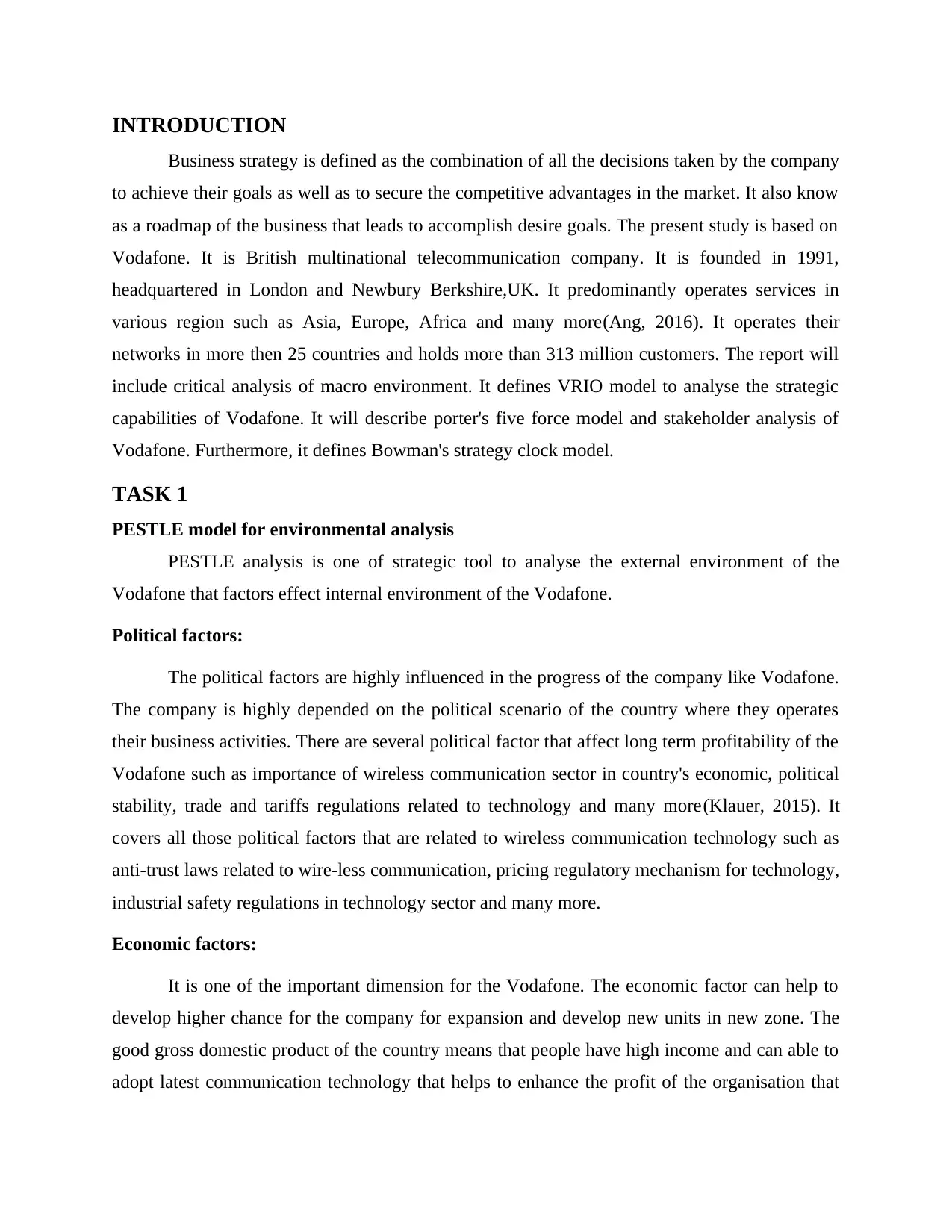
INTRODUCTION
Business strategy is defined as the combination of all the decisions taken by the company
to achieve their goals as well as to secure the competitive advantages in the market. It also know
as a roadmap of the business that leads to accomplish desire goals. The present study is based on
Vodafone. It is British multinational telecommunication company. It is founded in 1991,
headquartered in London and Newbury Berkshire,UK. It predominantly operates services in
various region such as Asia, Europe, Africa and many more(Ang, 2016). It operates their
networks in more then 25 countries and holds more than 313 million customers. The report will
include critical analysis of macro environment. It defines VRIO model to analyse the strategic
capabilities of Vodafone. It will describe porter's five force model and stakeholder analysis of
Vodafone. Furthermore, it defines Bowman's strategy clock model.
TASK 1
PESTLE model for environmental analysis
PESTLE analysis is one of strategic tool to analyse the external environment of the
Vodafone that factors effect internal environment of the Vodafone.
Political factors:
The political factors are highly influenced in the progress of the company like Vodafone.
The company is highly depended on the political scenario of the country where they operates
their business activities. There are several political factor that affect long term profitability of the
Vodafone such as importance of wireless communication sector in country's economic, political
stability, trade and tariffs regulations related to technology and many more(Klauer, 2015). It
covers all those political factors that are related to wireless communication technology such as
anti-trust laws related to wire-less communication, pricing regulatory mechanism for technology,
industrial safety regulations in technology sector and many more.
Economic factors:
It is one of the important dimension for the Vodafone. The economic factor can help to
develop higher chance for the company for expansion and develop new units in new zone. The
good gross domestic product of the country means that people have high income and can able to
adopt latest communication technology that helps to enhance the profit of the organisation that
Business strategy is defined as the combination of all the decisions taken by the company
to achieve their goals as well as to secure the competitive advantages in the market. It also know
as a roadmap of the business that leads to accomplish desire goals. The present study is based on
Vodafone. It is British multinational telecommunication company. It is founded in 1991,
headquartered in London and Newbury Berkshire,UK. It predominantly operates services in
various region such as Asia, Europe, Africa and many more(Ang, 2016). It operates their
networks in more then 25 countries and holds more than 313 million customers. The report will
include critical analysis of macro environment. It defines VRIO model to analyse the strategic
capabilities of Vodafone. It will describe porter's five force model and stakeholder analysis of
Vodafone. Furthermore, it defines Bowman's strategy clock model.
TASK 1
PESTLE model for environmental analysis
PESTLE analysis is one of strategic tool to analyse the external environment of the
Vodafone that factors effect internal environment of the Vodafone.
Political factors:
The political factors are highly influenced in the progress of the company like Vodafone.
The company is highly depended on the political scenario of the country where they operates
their business activities. There are several political factor that affect long term profitability of the
Vodafone such as importance of wireless communication sector in country's economic, political
stability, trade and tariffs regulations related to technology and many more(Klauer, 2015). It
covers all those political factors that are related to wireless communication technology such as
anti-trust laws related to wire-less communication, pricing regulatory mechanism for technology,
industrial safety regulations in technology sector and many more.
Economic factors:
It is one of the important dimension for the Vodafone. The economic factor can help to
develop higher chance for the company for expansion and develop new units in new zone. The
good gross domestic product of the country means that people have high income and can able to
adopt latest communication technology that helps to enhance the profit of the organisation that
⊘ This is a preview!⊘
Do you want full access?
Subscribe today to unlock all pages.

Trusted by 1+ million students worldwide

helps to Vodafone in the global expansion. The economic crisis and global uncertainty is
impacted negatively on Vodafone and made changes in their strategics. Recession period is also
effected the sales of the Vodafone so they have to change their policy according to recession
period and prices is also affected. The Vodafone have to reduces their prices to attract their
customers.
2
impacted negatively on Vodafone and made changes in their strategics. Recession period is also
effected the sales of the Vodafone so they have to change their policy according to recession
period and prices is also affected. The Vodafone have to reduces their prices to attract their
customers.
2
Paraphrase This Document
Need a fresh take? Get an instant paraphrase of this document with our AI Paraphraser

Social factor:
The impact of social factor is fully based on local beliefs and cultural of the people where
the company operates their business activities. Change in life style of the customers is also
affected the strategy of the Vodafone because customers also prefer the new technology and in
the new age of world rapidly change arises in the technology. So, the Vodafone have to change
their strategics according to customers life style, education level, attitudes and leisure interests
etc.(Davis and Higgins, 2015).
Technological factors:
Vodafone is famous for its innovations and their mission is always followed
contemporary trends of technology and communication. The products of the Vodafone is highly
related to technology. So, this factors is essential to keep in view of Vodafone. There are various
technological factors that impacts the profitability of the organisation such as recent technology
development by their competitors, impact on cost structure and value chain structure in wireless
communications industry, rate of technological diffusion and many more.
Legal factors:
Vodafone is a global company that have many rivals. The legal frameworks are impacted
the performance of the organisation because the legal factor do not help to protect the intellectual
property rights of the Vodafone. There are some legal factor that have to consider Vodafone in
their leadership such as discrimination law, health and safety law, employment law, data
protection in wireless communication industry.
Environmental factors:
Vodafone deals in various market and countries. Every market have different
environmental norms and standards that impacts profitability of the organisation in particular
market. With rise of global market, people are more ethics oriented. The consumers are also be
social responsible for their favourite brands and they always wants their brand to plays an
important role in the betterment of the society(Cibro, 2016). The working condition must be
good to attract the customers. There are some environment factors that affect the growth of the
Vodafone such as air and water pollution regulations, waste management in wireless
3
The impact of social factor is fully based on local beliefs and cultural of the people where
the company operates their business activities. Change in life style of the customers is also
affected the strategy of the Vodafone because customers also prefer the new technology and in
the new age of world rapidly change arises in the technology. So, the Vodafone have to change
their strategics according to customers life style, education level, attitudes and leisure interests
etc.(Davis and Higgins, 2015).
Technological factors:
Vodafone is famous for its innovations and their mission is always followed
contemporary trends of technology and communication. The products of the Vodafone is highly
related to technology. So, this factors is essential to keep in view of Vodafone. There are various
technological factors that impacts the profitability of the organisation such as recent technology
development by their competitors, impact on cost structure and value chain structure in wireless
communications industry, rate of technological diffusion and many more.
Legal factors:
Vodafone is a global company that have many rivals. The legal frameworks are impacted
the performance of the organisation because the legal factor do not help to protect the intellectual
property rights of the Vodafone. There are some legal factor that have to consider Vodafone in
their leadership such as discrimination law, health and safety law, employment law, data
protection in wireless communication industry.
Environmental factors:
Vodafone deals in various market and countries. Every market have different
environmental norms and standards that impacts profitability of the organisation in particular
market. With rise of global market, people are more ethics oriented. The consumers are also be
social responsible for their favourite brands and they always wants their brand to plays an
important role in the betterment of the society(Cibro, 2016). The working condition must be
good to attract the customers. There are some environment factors that affect the growth of the
Vodafone such as air and water pollution regulations, waste management in wireless
3

communication industry, attitude of the company towards renewable energy and ecological and
green products and many more.
Ansoff's growth vector matrix
This analysis is also called product/market expansion grid, that helps to organisation to
analyse and plan the strategies of the company for the growth(Harlow, 2016). This strategy
helps to identify corporate growth opportunities and their market, product with possible growth
opportunities that can be establish by introducing new product and merging current product with
new product. The ansoff matrix shows four strategies that used to analyse the risk that is
associated with strategies.
Market penetration:
In this strategy, Vodafone uses their existing products in existing market. The aim of the
firm is to increase its market shares with the help of this strategy. They can adopt many way to
accomplish their aim such as Vodafone can decrease prices to attract their existing and new
customers as well as increase promotion and distribution efforts.
Market development:
In this strategy, Vodafone develops new product to keeping their existing market. The
Vodafone involves extensive research and development as well as expand their product range.
This strategy is implemented when the firm have good understanding of their current market and
provides innovative solution to meet the expectation of the existing market(Ang, 2016).
Product development:
Vodafone develops new products for targetting its existing market segments. A product
development strategy may be appropriate if the strength of Vodafone is related to its specific
customers rather than specific product(Yin, 2016). This strategy carries more risk by increasing
market share. The Vodafone can be develop their products by investing in research and
development, acquisition to produce other products and joint development with other company
etc.
Diversification:
4
green products and many more.
Ansoff's growth vector matrix
This analysis is also called product/market expansion grid, that helps to organisation to
analyse and plan the strategies of the company for the growth(Harlow, 2016). This strategy
helps to identify corporate growth opportunities and their market, product with possible growth
opportunities that can be establish by introducing new product and merging current product with
new product. The ansoff matrix shows four strategies that used to analyse the risk that is
associated with strategies.
Market penetration:
In this strategy, Vodafone uses their existing products in existing market. The aim of the
firm is to increase its market shares with the help of this strategy. They can adopt many way to
accomplish their aim such as Vodafone can decrease prices to attract their existing and new
customers as well as increase promotion and distribution efforts.
Market development:
In this strategy, Vodafone develops new product to keeping their existing market. The
Vodafone involves extensive research and development as well as expand their product range.
This strategy is implemented when the firm have good understanding of their current market and
provides innovative solution to meet the expectation of the existing market(Ang, 2016).
Product development:
Vodafone develops new products for targetting its existing market segments. A product
development strategy may be appropriate if the strength of Vodafone is related to its specific
customers rather than specific product(Yin, 2016). This strategy carries more risk by increasing
market share. The Vodafone can be develop their products by investing in research and
development, acquisition to produce other products and joint development with other company
etc.
Diversification:
4
⊘ This is a preview!⊘
Do you want full access?
Subscribe today to unlock all pages.

Trusted by 1+ million students worldwide
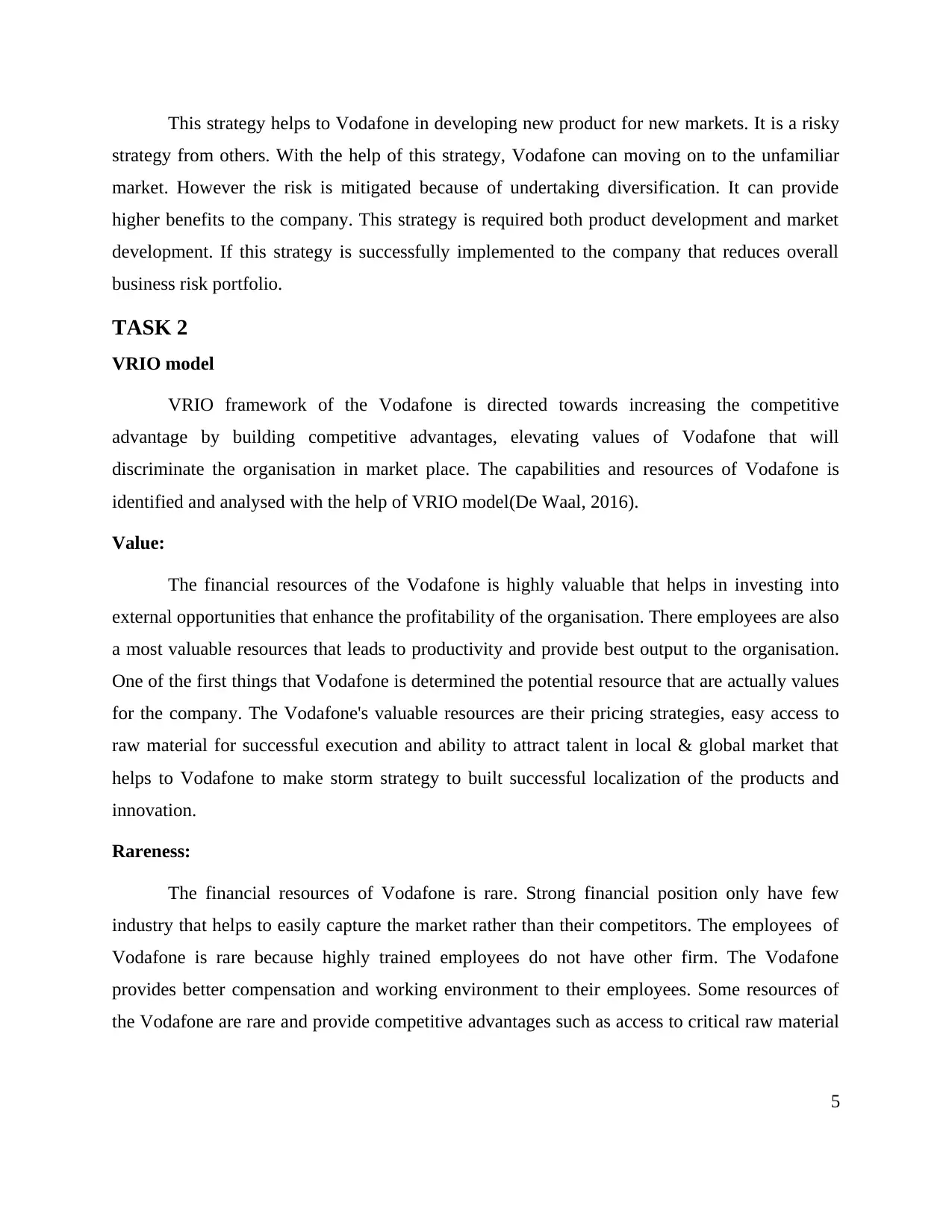
This strategy helps to Vodafone in developing new product for new markets. It is a risky
strategy from others. With the help of this strategy, Vodafone can moving on to the unfamiliar
market. However the risk is mitigated because of undertaking diversification. It can provide
higher benefits to the company. This strategy is required both product development and market
development. If this strategy is successfully implemented to the company that reduces overall
business risk portfolio.
TASK 2
VRIO model
VRIO framework of the Vodafone is directed towards increasing the competitive
advantage by building competitive advantages, elevating values of Vodafone that will
discriminate the organisation in market place. The capabilities and resources of Vodafone is
identified and analysed with the help of VRIO model(De Waal, 2016).
Value:
The financial resources of the Vodafone is highly valuable that helps in investing into
external opportunities that enhance the profitability of the organisation. There employees are also
a most valuable resources that leads to productivity and provide best output to the organisation.
One of the first things that Vodafone is determined the potential resource that are actually values
for the company. The Vodafone's valuable resources are their pricing strategies, easy access to
raw material for successful execution and ability to attract talent in local & global market that
helps to Vodafone to make storm strategy to built successful localization of the products and
innovation.
Rareness:
The financial resources of Vodafone is rare. Strong financial position only have few
industry that helps to easily capture the market rather than their competitors. The employees of
Vodafone is rare because highly trained employees do not have other firm. The Vodafone
provides better compensation and working environment to their employees. Some resources of
the Vodafone are rare and provide competitive advantages such as access to critical raw material
5
strategy from others. With the help of this strategy, Vodafone can moving on to the unfamiliar
market. However the risk is mitigated because of undertaking diversification. It can provide
higher benefits to the company. This strategy is required both product development and market
development. If this strategy is successfully implemented to the company that reduces overall
business risk portfolio.
TASK 2
VRIO model
VRIO framework of the Vodafone is directed towards increasing the competitive
advantage by building competitive advantages, elevating values of Vodafone that will
discriminate the organisation in market place. The capabilities and resources of Vodafone is
identified and analysed with the help of VRIO model(De Waal, 2016).
Value:
The financial resources of the Vodafone is highly valuable that helps in investing into
external opportunities that enhance the profitability of the organisation. There employees are also
a most valuable resources that leads to productivity and provide best output to the organisation.
One of the first things that Vodafone is determined the potential resource that are actually values
for the company. The Vodafone's valuable resources are their pricing strategies, easy access to
raw material for successful execution and ability to attract talent in local & global market that
helps to Vodafone to make storm strategy to built successful localization of the products and
innovation.
Rareness:
The financial resources of Vodafone is rare. Strong financial position only have few
industry that helps to easily capture the market rather than their competitors. The employees of
Vodafone is rare because highly trained employees do not have other firm. The Vodafone
provides better compensation and working environment to their employees. Some resources of
the Vodafone are rare and provide competitive advantages such as access to critical raw material
5
Paraphrase This Document
Need a fresh take? Get an instant paraphrase of this document with our AI Paraphraser
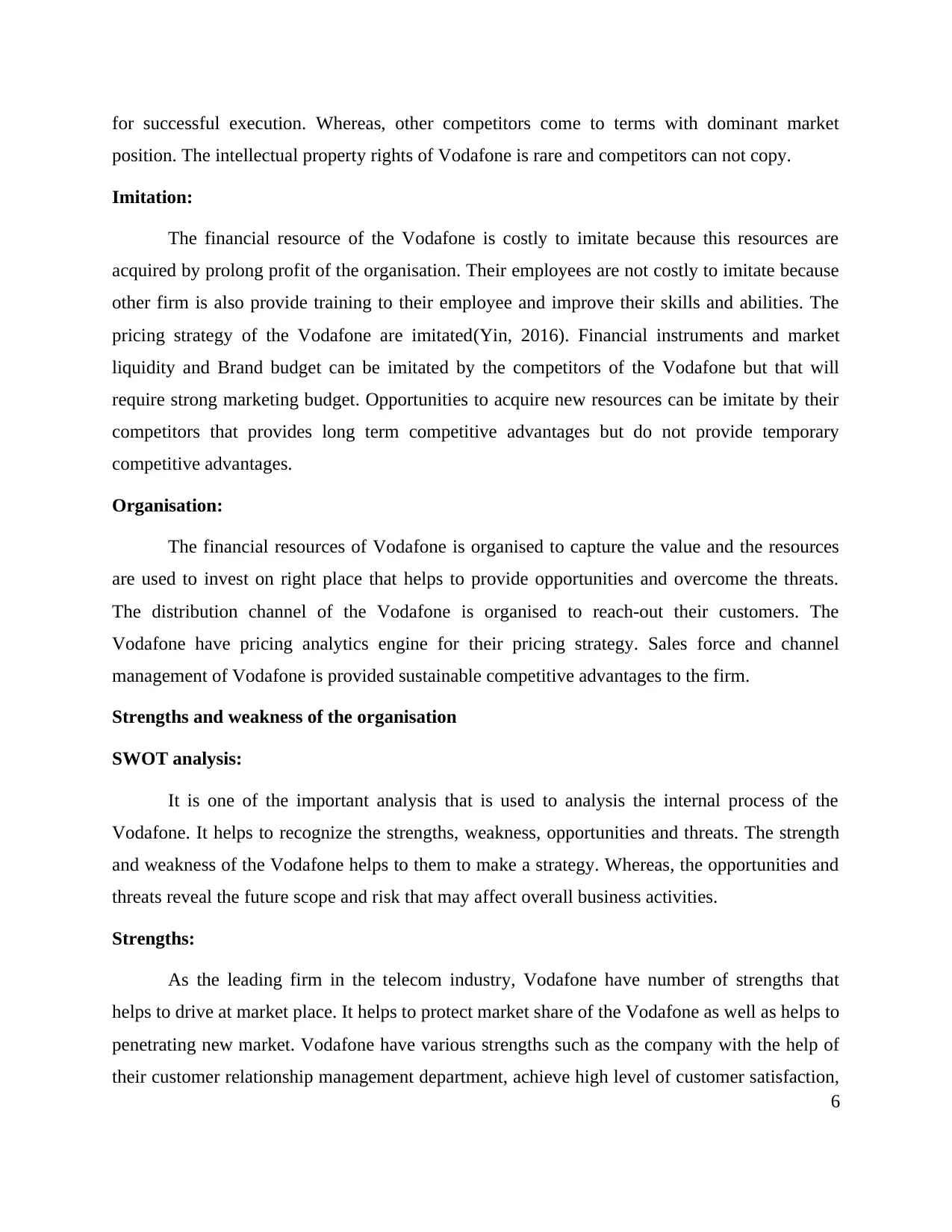
for successful execution. Whereas, other competitors come to terms with dominant market
position. The intellectual property rights of Vodafone is rare and competitors can not copy.
Imitation:
The financial resource of the Vodafone is costly to imitate because this resources are
acquired by prolong profit of the organisation. Their employees are not costly to imitate because
other firm is also provide training to their employee and improve their skills and abilities. The
pricing strategy of the Vodafone are imitated(Yin, 2016). Financial instruments and market
liquidity and Brand budget can be imitated by the competitors of the Vodafone but that will
require strong marketing budget. Opportunities to acquire new resources can be imitate by their
competitors that provides long term competitive advantages but do not provide temporary
competitive advantages.
Organisation:
The financial resources of Vodafone is organised to capture the value and the resources
are used to invest on right place that helps to provide opportunities and overcome the threats.
The distribution channel of the Vodafone is organised to reach-out their customers. The
Vodafone have pricing analytics engine for their pricing strategy. Sales force and channel
management of Vodafone is provided sustainable competitive advantages to the firm.
Strengths and weakness of the organisation
SWOT analysis:
It is one of the important analysis that is used to analysis the internal process of the
Vodafone. It helps to recognize the strengths, weakness, opportunities and threats. The strength
and weakness of the Vodafone helps to them to make a strategy. Whereas, the opportunities and
threats reveal the future scope and risk that may affect overall business activities.
Strengths:
As the leading firm in the telecom industry, Vodafone have number of strengths that
helps to drive at market place. It helps to protect market share of the Vodafone as well as helps to
penetrating new market. Vodafone have various strengths such as the company with the help of
their customer relationship management department, achieve high level of customer satisfaction,
6
position. The intellectual property rights of Vodafone is rare and competitors can not copy.
Imitation:
The financial resource of the Vodafone is costly to imitate because this resources are
acquired by prolong profit of the organisation. Their employees are not costly to imitate because
other firm is also provide training to their employee and improve their skills and abilities. The
pricing strategy of the Vodafone are imitated(Yin, 2016). Financial instruments and market
liquidity and Brand budget can be imitated by the competitors of the Vodafone but that will
require strong marketing budget. Opportunities to acquire new resources can be imitate by their
competitors that provides long term competitive advantages but do not provide temporary
competitive advantages.
Organisation:
The financial resources of Vodafone is organised to capture the value and the resources
are used to invest on right place that helps to provide opportunities and overcome the threats.
The distribution channel of the Vodafone is organised to reach-out their customers. The
Vodafone have pricing analytics engine for their pricing strategy. Sales force and channel
management of Vodafone is provided sustainable competitive advantages to the firm.
Strengths and weakness of the organisation
SWOT analysis:
It is one of the important analysis that is used to analysis the internal process of the
Vodafone. It helps to recognize the strengths, weakness, opportunities and threats. The strength
and weakness of the Vodafone helps to them to make a strategy. Whereas, the opportunities and
threats reveal the future scope and risk that may affect overall business activities.
Strengths:
As the leading firm in the telecom industry, Vodafone have number of strengths that
helps to drive at market place. It helps to protect market share of the Vodafone as well as helps to
penetrating new market. Vodafone have various strengths such as the company with the help of
their customer relationship management department, achieve high level of customer satisfaction,
6
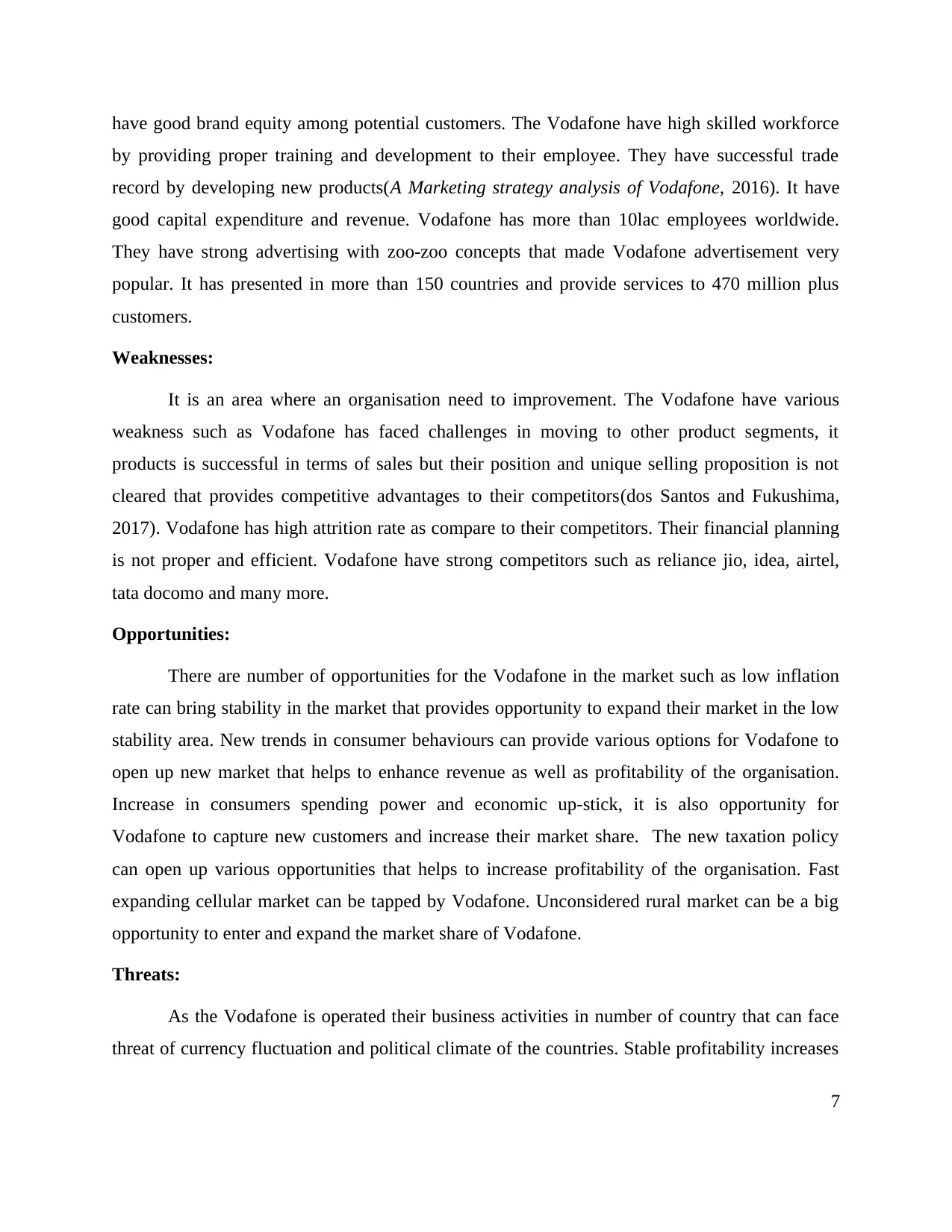
have good brand equity among potential customers. The Vodafone have high skilled workforce
by providing proper training and development to their employee. They have successful trade
record by developing new products(A Marketing strategy analysis of Vodafone, 2016). It have
good capital expenditure and revenue. Vodafone has more than 10lac employees worldwide.
They have strong advertising with zoo-zoo concepts that made Vodafone advertisement very
popular. It has presented in more than 150 countries and provide services to 470 million plus
customers.
Weaknesses:
It is an area where an organisation need to improvement. The Vodafone have various
weakness such as Vodafone has faced challenges in moving to other product segments, it
products is successful in terms of sales but their position and unique selling proposition is not
cleared that provides competitive advantages to their competitors(dos Santos and Fukushima,
2017). Vodafone has high attrition rate as compare to their competitors. Their financial planning
is not proper and efficient. Vodafone have strong competitors such as reliance jio, idea, airtel,
tata docomo and many more.
Opportunities:
There are number of opportunities for the Vodafone in the market such as low inflation
rate can bring stability in the market that provides opportunity to expand their market in the low
stability area. New trends in consumer behaviours can provide various options for Vodafone to
open up new market that helps to enhance revenue as well as profitability of the organisation.
Increase in consumers spending power and economic up-stick, it is also opportunity for
Vodafone to capture new customers and increase their market share. The new taxation policy
can open up various opportunities that helps to increase profitability of the organisation. Fast
expanding cellular market can be tapped by Vodafone. Unconsidered rural market can be a big
opportunity to enter and expand the market share of Vodafone.
Threats:
As the Vodafone is operated their business activities in number of country that can face
threat of currency fluctuation and political climate of the countries. Stable profitability increases
7
by providing proper training and development to their employee. They have successful trade
record by developing new products(A Marketing strategy analysis of Vodafone, 2016). It have
good capital expenditure and revenue. Vodafone has more than 10lac employees worldwide.
They have strong advertising with zoo-zoo concepts that made Vodafone advertisement very
popular. It has presented in more than 150 countries and provide services to 470 million plus
customers.
Weaknesses:
It is an area where an organisation need to improvement. The Vodafone have various
weakness such as Vodafone has faced challenges in moving to other product segments, it
products is successful in terms of sales but their position and unique selling proposition is not
cleared that provides competitive advantages to their competitors(dos Santos and Fukushima,
2017). Vodafone has high attrition rate as compare to their competitors. Their financial planning
is not proper and efficient. Vodafone have strong competitors such as reliance jio, idea, airtel,
tata docomo and many more.
Opportunities:
There are number of opportunities for the Vodafone in the market such as low inflation
rate can bring stability in the market that provides opportunity to expand their market in the low
stability area. New trends in consumer behaviours can provide various options for Vodafone to
open up new market that helps to enhance revenue as well as profitability of the organisation.
Increase in consumers spending power and economic up-stick, it is also opportunity for
Vodafone to capture new customers and increase their market share. The new taxation policy
can open up various opportunities that helps to increase profitability of the organisation. Fast
expanding cellular market can be tapped by Vodafone. Unconsidered rural market can be a big
opportunity to enter and expand the market share of Vodafone.
Threats:
As the Vodafone is operated their business activities in number of country that can face
threat of currency fluctuation and political climate of the countries. Stable profitability increases
7
⊘ This is a preview!⊘
Do you want full access?
Subscribe today to unlock all pages.

Trusted by 1+ million students worldwide
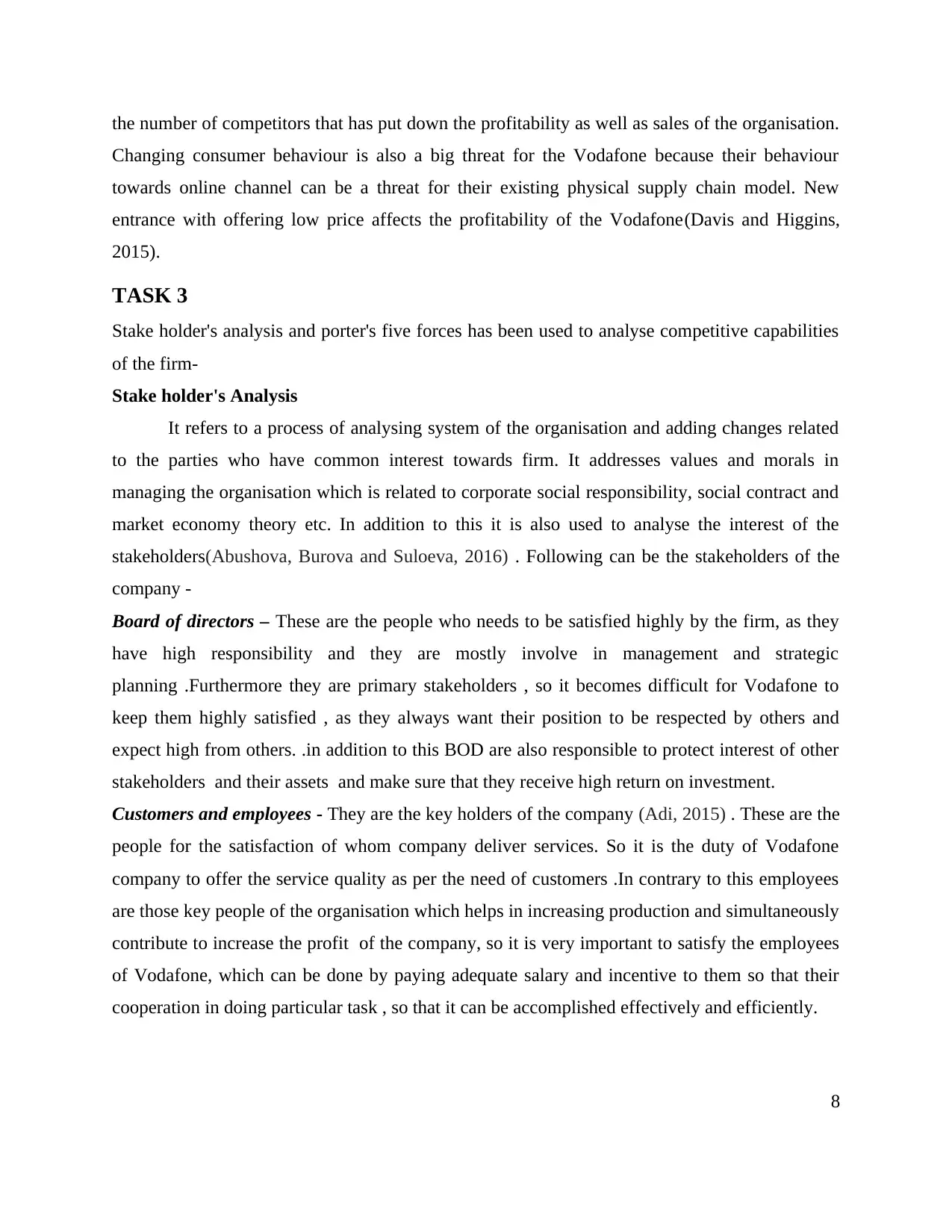
the number of competitors that has put down the profitability as well as sales of the organisation.
Changing consumer behaviour is also a big threat for the Vodafone because their behaviour
towards online channel can be a threat for their existing physical supply chain model. New
entrance with offering low price affects the profitability of the Vodafone(Davis and Higgins,
2015).
TASK 3
Stake holder's analysis and porter's five forces has been used to analyse competitive capabilities
of the firm-
Stake holder's Analysis
It refers to a process of analysing system of the organisation and adding changes related
to the parties who have common interest towards firm. It addresses values and morals in
managing the organisation which is related to corporate social responsibility, social contract and
market economy theory etc. In addition to this it is also used to analyse the interest of the
stakeholders(Abushova, Burova and Suloeva, 2016) . Following can be the stakeholders of the
company -
Board of directors – These are the people who needs to be satisfied highly by the firm, as they
have high responsibility and they are mostly involve in management and strategic
planning .Furthermore they are primary stakeholders , so it becomes difficult for Vodafone to
keep them highly satisfied , as they always want their position to be respected by others and
expect high from others. .in addition to this BOD are also responsible to protect interest of other
stakeholders and their assets and make sure that they receive high return on investment.
Customers and employees - They are the key holders of the company (Adi, 2015) . These are the
people for the satisfaction of whom company deliver services. So it is the duty of Vodafone
company to offer the service quality as per the need of customers .In contrary to this employees
are those key people of the organisation which helps in increasing production and simultaneously
contribute to increase the profit of the company, so it is very important to satisfy the employees
of Vodafone, which can be done by paying adequate salary and incentive to them so that their
cooperation in doing particular task , so that it can be accomplished effectively and efficiently.
8
Changing consumer behaviour is also a big threat for the Vodafone because their behaviour
towards online channel can be a threat for their existing physical supply chain model. New
entrance with offering low price affects the profitability of the Vodafone(Davis and Higgins,
2015).
TASK 3
Stake holder's analysis and porter's five forces has been used to analyse competitive capabilities
of the firm-
Stake holder's Analysis
It refers to a process of analysing system of the organisation and adding changes related
to the parties who have common interest towards firm. It addresses values and morals in
managing the organisation which is related to corporate social responsibility, social contract and
market economy theory etc. In addition to this it is also used to analyse the interest of the
stakeholders(Abushova, Burova and Suloeva, 2016) . Following can be the stakeholders of the
company -
Board of directors – These are the people who needs to be satisfied highly by the firm, as they
have high responsibility and they are mostly involve in management and strategic
planning .Furthermore they are primary stakeholders , so it becomes difficult for Vodafone to
keep them highly satisfied , as they always want their position to be respected by others and
expect high from others. .in addition to this BOD are also responsible to protect interest of other
stakeholders and their assets and make sure that they receive high return on investment.
Customers and employees - They are the key holders of the company (Adi, 2015) . These are the
people for the satisfaction of whom company deliver services. So it is the duty of Vodafone
company to offer the service quality as per the need of customers .In contrary to this employees
are those key people of the organisation which helps in increasing production and simultaneously
contribute to increase the profit of the company, so it is very important to satisfy the employees
of Vodafone, which can be done by paying adequate salary and incentive to them so that their
cooperation in doing particular task , so that it can be accomplished effectively and efficiently.
8
Paraphrase This Document
Need a fresh take? Get an instant paraphrase of this document with our AI Paraphraser
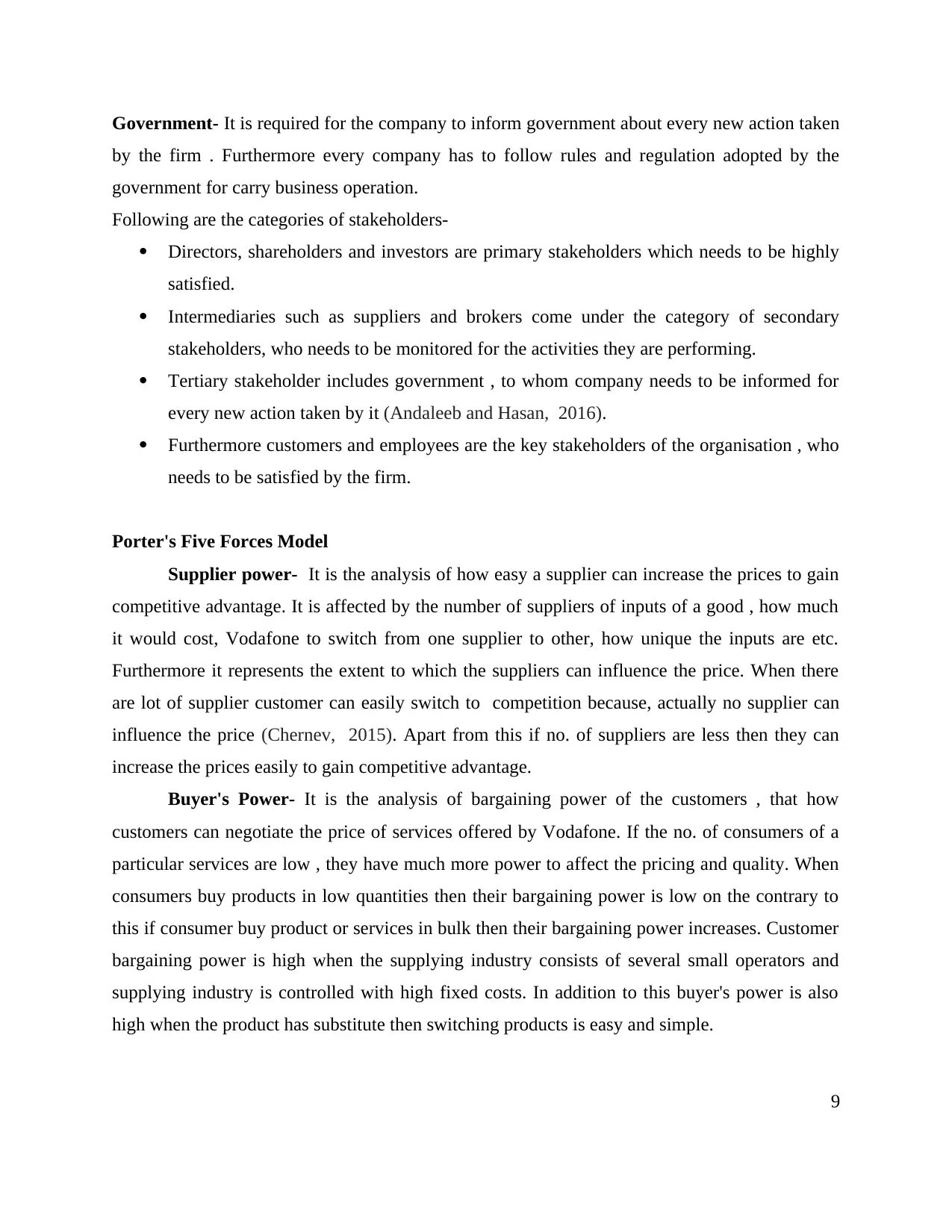
Government- It is required for the company to inform government about every new action taken
by the firm . Furthermore every company has to follow rules and regulation adopted by the
government for carry business operation.
Following are the categories of stakeholders-
Directors, shareholders and investors are primary stakeholders which needs to be highly
satisfied.
Intermediaries such as suppliers and brokers come under the category of secondary
stakeholders, who needs to be monitored for the activities they are performing.
Tertiary stakeholder includes government , to whom company needs to be informed for
every new action taken by it (Andaleeb and Hasan, 2016).
Furthermore customers and employees are the key stakeholders of the organisation , who
needs to be satisfied by the firm.
Porter's Five Forces Model
Supplier power- It is the analysis of how easy a supplier can increase the prices to gain
competitive advantage. It is affected by the number of suppliers of inputs of a good , how much
it would cost, Vodafone to switch from one supplier to other, how unique the inputs are etc.
Furthermore it represents the extent to which the suppliers can influence the price. When there
are lot of supplier customer can easily switch to competition because, actually no supplier can
influence the price (Chernev, 2015). Apart from this if no. of suppliers are less then they can
increase the prices easily to gain competitive advantage.
Buyer's Power- It is the analysis of bargaining power of the customers , that how
customers can negotiate the price of services offered by Vodafone. If the no. of consumers of a
particular services are low , they have much more power to affect the pricing and quality. When
consumers buy products in low quantities then their bargaining power is low on the contrary to
this if consumer buy product or services in bulk then their bargaining power increases. Customer
bargaining power is high when the supplying industry consists of several small operators and
supplying industry is controlled with high fixed costs. In addition to this buyer's power is also
high when the product has substitute then switching products is easy and simple.
9
by the firm . Furthermore every company has to follow rules and regulation adopted by the
government for carry business operation.
Following are the categories of stakeholders-
Directors, shareholders and investors are primary stakeholders which needs to be highly
satisfied.
Intermediaries such as suppliers and brokers come under the category of secondary
stakeholders, who needs to be monitored for the activities they are performing.
Tertiary stakeholder includes government , to whom company needs to be informed for
every new action taken by it (Andaleeb and Hasan, 2016).
Furthermore customers and employees are the key stakeholders of the organisation , who
needs to be satisfied by the firm.
Porter's Five Forces Model
Supplier power- It is the analysis of how easy a supplier can increase the prices to gain
competitive advantage. It is affected by the number of suppliers of inputs of a good , how much
it would cost, Vodafone to switch from one supplier to other, how unique the inputs are etc.
Furthermore it represents the extent to which the suppliers can influence the price. When there
are lot of supplier customer can easily switch to competition because, actually no supplier can
influence the price (Chernev, 2015). Apart from this if no. of suppliers are less then they can
increase the prices easily to gain competitive advantage.
Buyer's Power- It is the analysis of bargaining power of the customers , that how
customers can negotiate the price of services offered by Vodafone. If the no. of consumers of a
particular services are low , they have much more power to affect the pricing and quality. When
consumers buy products in low quantities then their bargaining power is low on the contrary to
this if consumer buy product or services in bulk then their bargaining power increases. Customer
bargaining power is high when the supplying industry consists of several small operators and
supplying industry is controlled with high fixed costs. In addition to this buyer's power is also
high when the product has substitute then switching products is easy and simple.
9
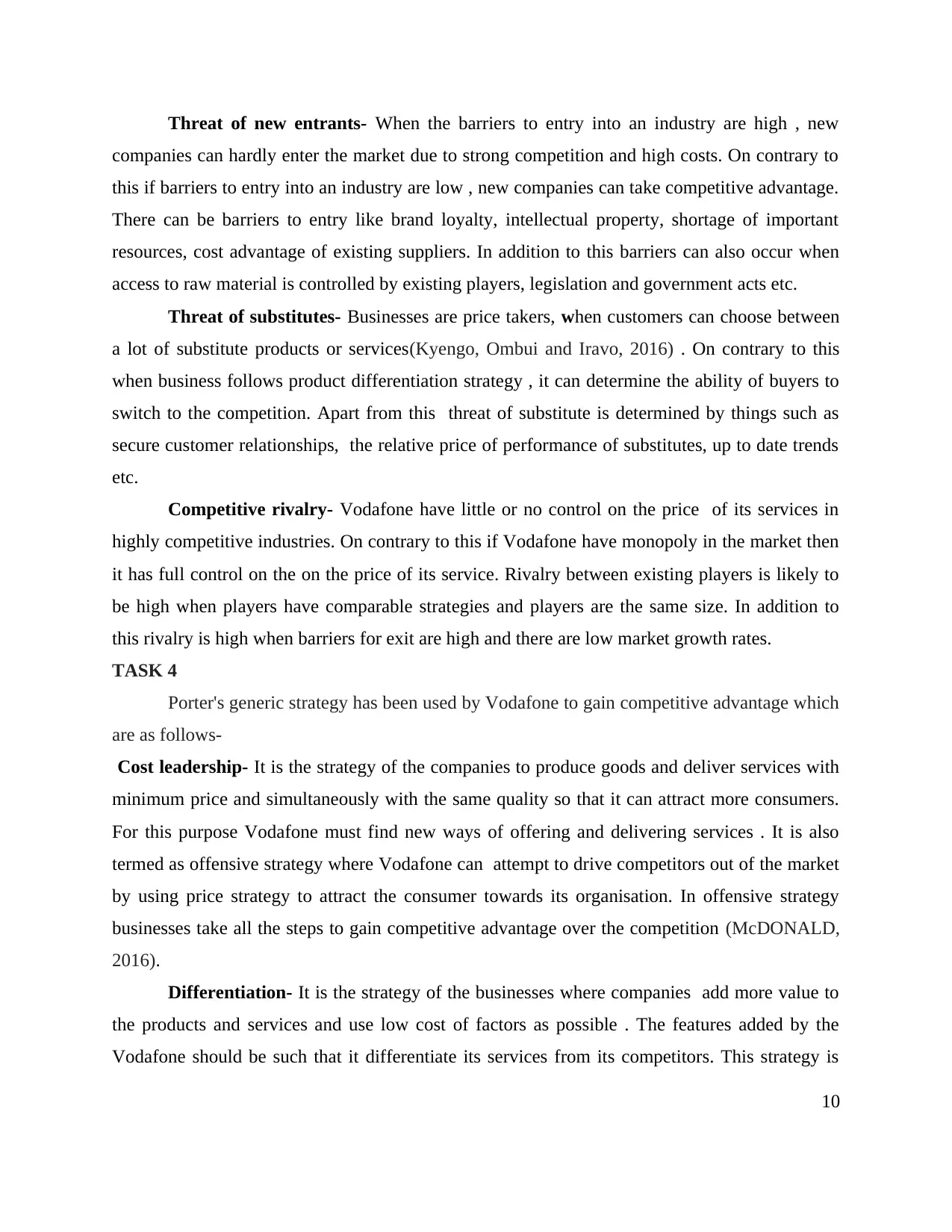
Threat of new entrants- When the barriers to entry into an industry are high , new
companies can hardly enter the market due to strong competition and high costs. On contrary to
this if barriers to entry into an industry are low , new companies can take competitive advantage.
There can be barriers to entry like brand loyalty, intellectual property, shortage of important
resources, cost advantage of existing suppliers. In addition to this barriers can also occur when
access to raw material is controlled by existing players, legislation and government acts etc.
Threat of substitutes- Businesses are price takers, when customers can choose between
a lot of substitute products or services(Kyengo, Ombui and Iravo, 2016) . On contrary to this
when business follows product differentiation strategy , it can determine the ability of buyers to
switch to the competition. Apart from this threat of substitute is determined by things such as
secure customer relationships, the relative price of performance of substitutes, up to date trends
etc.
Competitive rivalry- Vodafone have little or no control on the price of its services in
highly competitive industries. On contrary to this if Vodafone have monopoly in the market then
it has full control on the on the price of its service. Rivalry between existing players is likely to
be high when players have comparable strategies and players are the same size. In addition to
this rivalry is high when barriers for exit are high and there are low market growth rates.
TASK 4
Porter's generic strategy has been used by Vodafone to gain competitive advantage which
are as follows-
Cost leadership- It is the strategy of the companies to produce goods and deliver services with
minimum price and simultaneously with the same quality so that it can attract more consumers.
For this purpose Vodafone must find new ways of offering and delivering services . It is also
termed as offensive strategy where Vodafone can attempt to drive competitors out of the market
by using price strategy to attract the consumer towards its organisation. In offensive strategy
businesses take all the steps to gain competitive advantage over the competition (McDONALD,
2016).
Differentiation- It is the strategy of the businesses where companies add more value to
the products and services and use low cost of factors as possible . The features added by the
Vodafone should be such that it differentiate its services from its competitors. This strategy is
10
companies can hardly enter the market due to strong competition and high costs. On contrary to
this if barriers to entry into an industry are low , new companies can take competitive advantage.
There can be barriers to entry like brand loyalty, intellectual property, shortage of important
resources, cost advantage of existing suppliers. In addition to this barriers can also occur when
access to raw material is controlled by existing players, legislation and government acts etc.
Threat of substitutes- Businesses are price takers, when customers can choose between
a lot of substitute products or services(Kyengo, Ombui and Iravo, 2016) . On contrary to this
when business follows product differentiation strategy , it can determine the ability of buyers to
switch to the competition. Apart from this threat of substitute is determined by things such as
secure customer relationships, the relative price of performance of substitutes, up to date trends
etc.
Competitive rivalry- Vodafone have little or no control on the price of its services in
highly competitive industries. On contrary to this if Vodafone have monopoly in the market then
it has full control on the on the price of its service. Rivalry between existing players is likely to
be high when players have comparable strategies and players are the same size. In addition to
this rivalry is high when barriers for exit are high and there are low market growth rates.
TASK 4
Porter's generic strategy has been used by Vodafone to gain competitive advantage which
are as follows-
Cost leadership- It is the strategy of the companies to produce goods and deliver services with
minimum price and simultaneously with the same quality so that it can attract more consumers.
For this purpose Vodafone must find new ways of offering and delivering services . It is also
termed as offensive strategy where Vodafone can attempt to drive competitors out of the market
by using price strategy to attract the consumer towards its organisation. In offensive strategy
businesses take all the steps to gain competitive advantage over the competition (McDONALD,
2016).
Differentiation- It is the strategy of the businesses where companies add more value to
the products and services and use low cost of factors as possible . The features added by the
Vodafone should be such that it differentiate its services from its competitors. This strategy is
10
⊘ This is a preview!⊘
Do you want full access?
Subscribe today to unlock all pages.

Trusted by 1+ million students worldwide
1 out of 18
Related Documents
Your All-in-One AI-Powered Toolkit for Academic Success.
+13062052269
info@desklib.com
Available 24*7 on WhatsApp / Email
![[object Object]](/_next/static/media/star-bottom.7253800d.svg)
Unlock your academic potential
Copyright © 2020–2025 A2Z Services. All Rights Reserved. Developed and managed by ZUCOL.




